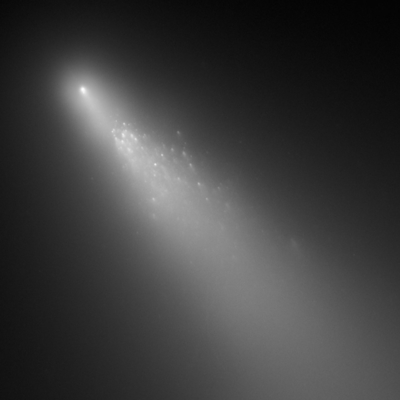73P/Schwassmann-Wachmann is proving to be a far more interesting object than first anticipated. The comet is closing toward the Sun and will swing around it on June 7, passing the Earth along the way at a distance of 11.7 million kilometers. The fascination comes from watching its ongoing disintegration, which has broken the comet into more than 30 separate fragments.
Nor is the show over. The larger fragments appear to be continuing their breakup. In the image below, taken by the Hubble Space Telescope, you can see one of the major fragments breaking into smaller chunks, dozens of which trail behind the main piece. The chunks are evidently pushed back along the tail by outgassing from their Sun-facing surfaces, and the smallest of them seem to be dissipating completely over a multi-day period.

Image: The second image from a three-day observation with Hubble showing the breakup of Comet 73P/Schwassmann-Wachmann 3’s Fragment B. Credit: NASA, ESA, H. Weaver (APL/JHU), M. Mutchler and Z. Levay (STScI).
As far back as 1995, 73P/Schwassmann-Wachmann was seen to be active, brightening a thousand-fold during the period of observation with five separate nuclei subsequently identified. The comet’s orbit takes it around the Sun every 5.4 years, but the next detection in 2000-2001 revealed only three fragments. This time around the show is considerably more interesting. It seems likely that what we are seeing now is an accelerated disintegration of the comet, making it open to conjecture how many of these fragments will be around to view in 2011-12.
Fragments B and C should be visible with binoculars on closest approach to Earth, which will occur on May 11. Neither object should be that remarkable unless another outburst occurs. But if it does, backyard astronomers may have quite a show to look at. The breakup process, observed in numerous earlier comets, is always accompanied by significant brightening. It was, in fact, the initial breakup of Shoemaker-Levy 9 in 1992 that made this famous comet bright enough to be detected eight months later. Shoemaker-Levy had its date with destiny when its fragments plowed into Jupiter in 1994, but 73P/Schwassmann-Wachmann poses no threat whatsoever to Earth.


IRCS/Subaru Observations of Water in the Inner Coma of Comet 73P-B/Schwassmann-Wachmann 3: Spatially Resolved Rotational Temperatures and Ortho-Para Ratios
Authors: Boncho P . Bonev, Michael J. Mumma, Hideyo Kawakita, Hitomi Kobayashi, Geronimo L. Villanueva
(Submitted on 28 Mar 2008)
Abstract: Comet 73P-B/Schwassmann-Wachmann 3 was observed with IRCS/Subaru at geocentric distance of 0.074 AU on UT 10 May 2006. Multiple H2O emission lines were detected in non-resonant fluorescence near 2.9 microns. No significant variation in total H2O production rate was found during the (3 hour) duration of our observations. H2O rotational temperatures and ortho-to-para abundance ratios were measured for several positions in the coma. The temperatures extracted from two different time intervals show very similar spatial distributions. For both, the rotational temperature decreased from ~110 K to ~90 K as the projected distance from the nucleus increased from ~5 to ~30 km. We see no evidence for OPR change in the coma. The H2O ortho-para ratio is consistent with the statistical equilibrium value (3.0) for all spatially resolved measurements. This implies a nuclear spin temperature higher than ~ 45 K.
Comments: accepted for Icarus
Subjects: Astrophysics (astro-ph)
Cite as: arXiv:0803.4099v1 [astro-ph]
Submission history
From: Boncho Bonev [view email]
[v1] Fri, 28 Mar 2008 12:27:58 GMT (517kb)
http://arxiv.org/abs/0803.4099